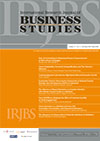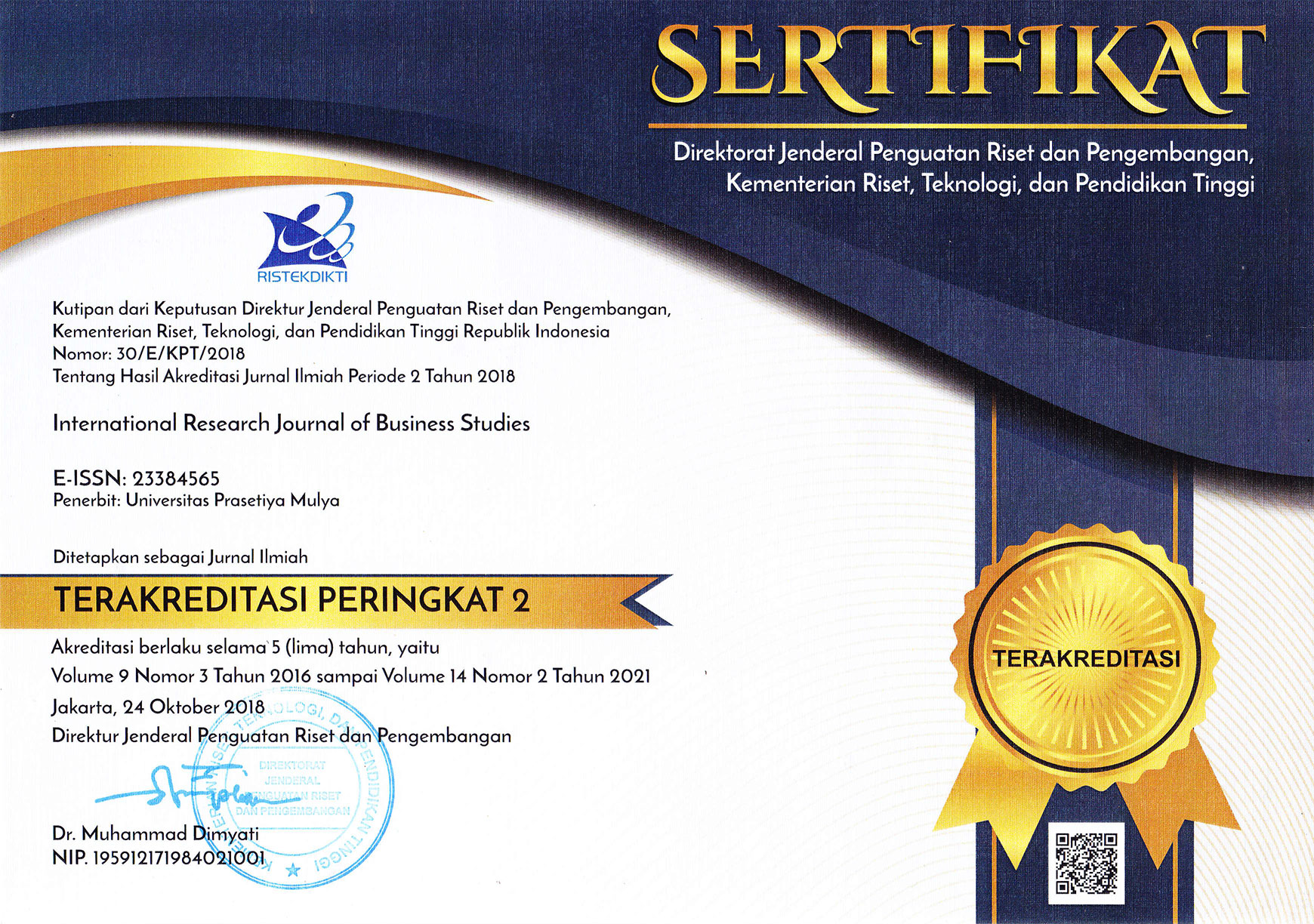Consumer Global Orientation and Its Impact on Consumers’ Positive Emotions
DOI:
https://doi.org/10.21632/irjbs.11.2.81-92Keywords:
Consumer global orientation, inferior image of local brands, foreign brand admirationAbstract
The objective of this study is to examine the role of consumer global orientation and the inferior image of foreign brands in young, educated consumers’ admiration for foreign brands and their willingness to pay more for foreign brands. The sample of this study was used students of the University of Mataram. Data collected in a classroom at the end of lecture by using a carefully developed instrument that has been carefully developed and well validated. Its findings suggest that consumer global orientation and the inferior image of local brands have no direct effect on consumers’ willingness to pay more for foreign brands. Nonetheless, they do indirectly affects consumer intentions by creating positive emotions about foreign brands. This positive emotion, i.e. foreign brand admiration, seems to have a critical role, as it fully mediates the effects of the two constructs. Consumer global orientation and the inferior image of local brands nurture consumers’ positive views of foreign brands, which in turn increase consumer willingness to pay higher prices for foreign brands. This study also conceptualizes consumer global orientation and provides the essential recommendations for future research.
References
Aaker, J.L., Garbinsky, E.N., and Vohs, K.D. (2012). Cultivating admiration in brands: warmth, competence, landing in the golden quadrant, Journal of Consumer Psycology, 22,191-194.
Balabanis, G., Diamantopoulos, A., Mueller, R.D and Melewar, T.C. (2001) The impact of nationalism, patriotism and internationalism on consumer ethnocentric tendency, Journal of International Business Studies, .32(1), 157 -175.
Bhardwaj, V., A. Kumar, and Y.-K. Kim. (2010). Brand Analyses of U.S. Global and Local Brands inIndia: The Case of Levi’s. Journal of Global Marketing 23 80–94.Wine Business Research, 26(2 ), 97-119.
Chang, C. (2008). The Effectiveness of Using global look in an Asian Market. Journal of Advertising Research, June, 199 - 214
Chu, P.-Y., C.-C. Chang, C.-Y. Chen, and T.-Y. Wang. (2010). Countering negative country of origin effects The role of evaluation mode. European Journal of Marketing, 44 (7/8),1055-1076.
Diamantopoulos, A., B. B. Schlegelmilch, and D. Palihawadana. (2009). Country of Origin: A construct past its sell by date?, American Marketing Association, winter, 318-327.
Dikčius, V., and G. Stankevičienė. (2010). Perception of country of brand origin and country of product manufacturing among Lithuanians and emigrants from Lithuania. Organizations and Markets in Emerging Economies, 1(2),108 - 122.
Fornell, C., & Larcker, D. F. (1981). Evaluating structural equation models with unobservable variables and measurement error, Journal of Marketing Research, 18(1), 39–50.
Frank, (2016), Exploring antecedents and consequences of young consumers’ perceived global brand equity. Journal of Product & Brand Management, 25(2). http://dx.doi.org/10.1108/JPBM-01-2015-0786
Gineikiene, J., Schlegelmilc, B.B., and Auruskeviciene,V. (2017). ’’ours’’ or ’’Theirs’’? Psycological ownership and domestic products references, Journal of Business Research, 72,93-103.
Halkias, G., Davvetas, V. and Diamanopoulos. (2016). The interplay between country stereotypes and perceived brand globalness/localness as drives of brand preference. Journal of Business Research, September, 3621-3628.
Hair, J.F., Black, W.C, Babin, B.J., Anderson, R.E., and Tatham, R.L. (2010). Multivariate Data Analysis. Pearson Education International. New Jersey.
Herstein, R., Roger. R. and Jaffe, E.D. (2014). How Companies from developing and emerging countries can leverage their brand equity in terms of place branding, Competitiveness Review, 24(4), 293-305.
Jin, Z., Chansarkar, B., and Kondap, N.M. (2006). Brand origin in an emerging market: perceptions of Indian consumers, Asia Pacific Journal of Marketing and Logistic. 18(4),283-302.
Kaufmann, H.R, Laureiro, S.M.C, and Manarioti, A., (2016). Exploring behavioral branding, brand love and brand co-creation. Journal of Product and Brand Management, 25(6), 516-526.
Kinra, N. (2006). the effect of country of origin on foreign brand names in the Indian Market, Marketing Intelligence and Planning, 24(1),15-30.
Kumar, A. Lee, H. and Kim, Y. (2009). Indian Consumers’ purchase intention toward a united states versus local brand, Journal of Business Research, 62,521-527.
Lee, M., Knight, D. and Kim, Y. (2008). Brand Analysis of a US global brand in comparison with domestic brands in Mexico, Korea and Japan. Journal of Product and Brand Management, 17(3),163-174.
Maher, A.A., Clark, P. and Maher. A. (2010). International consumer admiration and the persistence of animosity, Journal of Consumer Marketing, 27(5), 414-424.
Naseem, N. Verma S., and Yaprak, A. (2015). “Global Brand Attitude, Perceived Value, Consumer Affinity, and Purchase Intentions: A Multidimensional View of Consumer Behavior and Global Brands”, In International Marketing in the Fast Changing World, Advance in International Marketing, 26, 55-288. http://dx.doi.org/10.1108/S1474-797920150000026012
Nejati, M. and Moghaddam, P.P. (2012). Gender differences in hedonic values, utilitarian values and behavioural intentions of young consumers: insight from Iran, Young Consumers, 13(4), 337-344.
Nelissen, R.M.A., and Meijers, M.H.C. (2011). Social benefits of luxury brands as costly signals of wealth and status. Evolution and Human Behaviour, 32, 343-355.
Noh, M., Runyan, R. and Mosier, J. (2014). Young consumer’s innovatiness and hedonic/utilitarian cool attitudes, International Journal of Retail and Distribution Management, 42(4), 267-280.
Phau, I. (2010). An Australian perspective of the effects of brand image and product quality on diffusion brands of designer jeans. Journal of Global Business and Technology, 6(1/Spring), 41-51.
Pham, H. C., and B. Richards. (2015). The western brands in the minds of vietnamese consumers. Journal of Consumer Marketing, 32(5). http://dx.doi.org/10.1108/JCM-09-2014-1159
Riefler, P. (2012). Why consumers do (not) like global brands: The role of globalization attiitude, GCO and global brand origin, International Journal Research in Marketing, 29, 25-34.
Srivastava, R. K. (2011). Understanding brand identity confusion. Marketing Intelligence & Planning 29(4), 340-352.
Thanasuta, K. Patoomsumawan, T. Chaimahawong, V. and Chiaravutthi, Y. (2009). Brand and country of origin valuations of automobiles, Asia Pacific Journal of Marketing and Logistic. 21(3), 355-375.
Zhou, L., Z. Yang, and M. K. Hui. (2010). Non-local or local brands? A multi-level investigation into confidence in brand origin identification and its strategic implications, Journal of the Academy Marketing. Science. 38, 202-218.
Zhu, X., Yu., C. and Hu, S. (2016). Love for one’s country or oneself: A brand-choice framework in emerging markets, Social Behaviour and Personality, 44(2), 325-338.
Zhuang, G., X. Wang, L. Zhou, and N. Zhou. (2008). Asymmetric effects of brand origin confusion Evidence from the emerging market of China. International Marketing Review, 25(4), 441-457.
Downloads
Submitted
Published
How to Cite
Issue
Section
License
Copyright (c) 2018 Sulhaini, Rahman Dayani, Sulaimiah, Rusdan

This work is licensed under a Creative Commons Attribution-ShareAlike 4.0 International License.
Journal Author(s) Rights
For IRJBS to publish and disseminate research articles, we need publishing rights (transferred from the author(s) to the publisher). This is determined by a publishing agreement between the Author(s) and IRJBS. This agreement deals with the transfer or license of the copyright of publishing to IRJBS, while Authors still retain significant rights to use and share their own published articles. IRJBS supports the need for authors to share, disseminate and maximize the impact of their research and these rights, in any databases.
As a journal Author, you have rights to many uses of your article, including use by your employing institute or company. These Author rights can be exercised without the need to obtain specific permission. Authors publishing in IRJBS journals have comprehensive rights to use their works for teaching and scholarly purposes without needing to seek permission, including:
- use for classroom teaching by Author or Author's institution and presentation at a meeting or conference and distributing copies to attendees;
- use for internal training by the author's company;
- distribution to colleagues for their research use;
- use in a subsequent compilation of the author's works;
- inclusion in a thesis or dissertation;
- reuse of portions or extracts from the article in other works (with full acknowledgment of the final article);
- preparation of derivative works (other than commercial purposes) (with full acknowledgment of the final article);
- voluntary posting on open websites operated by the author or the author’s institution for scholarly purposes,
(But it should follow the open access license of Creative Common CC-by-SA License).
Authors/Readers/Third Parties can copy and redistribute the material in any medium or format, as well as remix, transform, and build upon the material for any purpose, even commercially. Still, they must give appropriate credit (the name of the creator and attribution parties (authors' detail information), a copyright notice, an open access license notice, a disclaimer notice, and a link to the material), provide a link to the license, and indicate if changes were made (Publisher indicates the modification of the material (if any) and retain an indication of previous modifications.
Authors/Readers/Third Parties can read, print and download, redistribute or republish the article (e.g. display in a repository), translate the article, download for text and data mining purposes, reuse portions or extracts from the article in other works, sell or re-use for commercial purposes, remix, transform, or build upon the material, they must distribute their contributions under the same license as the original Creative Commons Attribution-ShareAlike (CC BY-SA).
This work is licensed under a Creative Commons Attribution-ShareAlike 4.0 International License.








